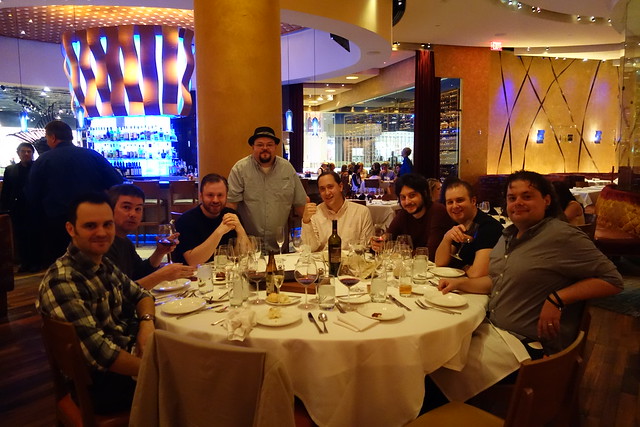A couple of people have reached out to me via LinkedIn and reminded me that my three year work anniversary happened last Friday. Three years since I left my job at a local place to go work for the Canonical where I got the chance to be paid to work on open source software and better my Python skills with the team working on Launchpad. My wife wasn’t quite sure. “You’ve only been at your job a year and a half, and your last one was only two years. What makes this different?”
What’s amazing, looking back, is just how *right* the decision turned out to be. I was nervous at the time. I really wasn’t Launchpad’s biggest fan. However, the team I interviewed with held this promise of making me a better developer. They were doing code reviews of every branch that went up to land. They had automated testing, and they firmly believed in unit and functional tests of the code. It was a case of the product didn’t excite me, but the environment, working with smart developers from across the globe, was exactly what I felt like I needed to move forward with my career, my craft.
I joined my team on Launchpad in a squad of four other developers. It was funny. When I joined I felt so lost. Launchpad is an amazing and huge bit of software, and I knew I was in over my head. I talked with my manager at the time, Deryck, and he told me “Don’t worry, it’ll take you about a year to get really productive working on Launchpad.” A year! Surely you jest, and if you’re not jesting…wtf did I just get myself into?
It was a long road and over time I learned how to take a code review (a really hard skill for many of us), how to do one, and how to talk with other smart and opinionated developers. I learned the value of the daily standup, how to manage work across a kanban board. I learned to really learn from others. Up until this point I’d always been the big fish in a small pond and suddenly I was the minnow hiding in the shallows. Forget books on how to code, just look at the diff in the code review you’re reading right now. Learn!
My boss was right, it was nearly ten months before I really felt like I could be asked to do most things in Launchpad and get them done in an efficient way. Soon our team was moved on from Launchpad to other projects. It was actually pretty great. On the one hand, “Hey! I just got the hang of this thing” but, on the other hand, we were moving on to new things. Development life here has never been one of sitting still. We sit down and work on the Ubuntu cycle of six month plans, and it’s funny because even that is such a long time. Do you really know what you’ll be doing six months from now?
Since that time in Launchpad I’ve gotten work on several different projects and I ended up switching teams to work on the Juju Gui. I didn’t really know a lot about this Juju thing, but the Gui was a fascinating project. It’s a really large scale JavaScript application. This is no “toss some jQuery on a web page” thing here.
I also moved to work under a new manager Gary. As my second manager since starting at Canonical and I was amazed at my luck. Here I’ve had two great mentors that made huge strides in teaching me how to work with other developers, how to do the fun stuff, the mundane, and how to take pride in the accomplishments of the team. I sit down at my computer every day and I’ve got the brain power of amazing people at my disposal over irc, Google Hangouts, email, and more. It’s amazing to think that at these sprints we do, I’m pretty much never the smartest person in the room. However, that’s what’s so great. It’s never boring and when there’s a problem the key is that we put our joint brilliant minds to the problem. In every hard problem we’ve faced I’ve never found that a single person had the one true solution. What we come up with together is always better than what any of us had apart.
When Gary left and there was a void for team lead and it was something I was interested in. I really can’t say enough awesome things about the team of folks I work with. I wanted to keep us all together and I felt like it would be great for us to try to keep things going. It was kind of a “well I’ll just try not to $#@$@# it up” situation. That was more than nine months ago now. Gary and Deryck taught me so much, and I still have to bite my tongue and ask myself “What would Gary do” at times. I’ve kept some things the same, but I’ve also brought my own flavor into the team a bit, at least I like to think so. These days my Github profile doesn’t show me landing a branch a day, but I take great pride in the progress of the team as a whole each and every week.
The team I run now is as awesome a group of people, the best I could hope to work for. I do mean that, I work for my team. It’s never the other way around and that’s one lesson I definitely picked up from my previous leads. The projects we’re working on are exciting and new and are really important to Canonical. I get to sit in and have discussions and planning meetings with Canonical super genius veterans like Kapil, Gustavo, and occasionally Mark Shuttleworth himself.
Looking back I’ve spent the last three years becoming a better developer, getting an on the job training course on leading a team of brilliant people, and crash course on thinking about the project, not just as the bugs or features for the week, but for the project as it needs to exist in three to six months. I’ve spent three years bouncing between “what have I gotten myself into, this is beyond my abilities” to “I’ve got this. You can’t find someone else to do this better”. I always tell people that if you’re not swimming as hard as you can to keep up, find another job. I feel like three years ago I did that and I’ve been swimming ever since.
Three years is a long time in a career these days. It’s been a wild ride and I can’t thank the folks that let me in the door, taught me, and have given me the power to do great things with my work enough. I’ve worked by butt off in Budapest, Copenhagen, Cape Town, Brussels, North Carolina, London, Vegas, and the bay area a few times. Will I be here three years from now? Who knows, but I know I’ve got an awesome team to work with on Monday and we’ll be building an awesome product to keep building. I’m going to really enjoy doing work that’s challenging and fulfilling every step of the way.




